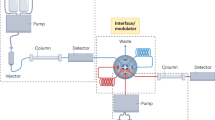Abstract
High-performance liquid chromatography (HPLC) is a chromatographic technique of great versatility and analytical power that can be applied to any compound with solubility in a liquid that can be used as the mobile phase. HPLC is widely used in food analysis to quantitate small molecules and ions and to separate and purify macromolecules. This chapter describes the details and various options for each of the HPLC system components: pump, injector, column, detector, and data system. A broad variety of column packing materials have contributed greatly to the widespread use of HPLC. The chapter includes details and example applications for separations achieved with normal-phase, reversed phase, hydrophobic interaction, ion-exchange, size-exclusion, and affinity chromatography.
Similar content being viewed by others
References
Bidlingmeyer BA (1993) Practical HPLC methodology and applications. Wiley, New York
Matissek R, Wittkowski R (eds) (1993) High performance liquid chromatography in food control and research. Behr’s Verlag, Hamburg, Germany
Nollet LML, Toldra F (eds) (2012) Food analysis by HPLC, 3rd edn. Marcel Dekker, New York
Macrae R (ed) (1988) HPLC in food analysis, 2nd edn. Academic, New York, NY
Harris DC (2015) Quantitative chemical analysis, 9th edn. W.H. Freeman and Co., New York
Hanai T (2004) HPLC: a practical guide. The Royal Society of Chemistry, Cambridge
Swadesh J (ed) (2000) HPLC: practical and industrial applications, 2nd edn. CRC, Boca Raton, FL
Lough WJ, Wainer IW (eds) (2008) High performance liquid chromatography: fundamental principles and practice. Springer, New York
LaCourse WR (2000) Column liquid chromatography: equipment and instrumentation (fundamental review). Anal Chem 72: 37R–51R
Gertz C (1990) HPLC tips and tricks. LDC Analytical, Riviera Beach, FL
Snyder LR, Kirkland JJ, Glajch JL (2012) Practical HPLC Method Development. John Wiley & Sons, Hoboken, New Jersey
Ishii D (ed) (1988) Introduction to microscale high-performance liquid chromatography. VCH Publishers, New York
Dorsey JG, Cooper WT, Siles BA, Foley JP, Barth HG (1996) Liquid chromatography: theory and methodology (fundamental review). Anal Chem 68:515R–568R
Waters Corporation (2014) Beginners Guide to UPLC: Ultra-Performance Liquid Chromatography (Waters Series) 1st edn. Milford MA
Unger KK (1990) Packings and stationary phases in chromatographic techniques. Marcel Dekker, New York
Gregory JF, Sartain DB (1991) Improved chromatographic determination of free and glycosylated forms of vitamin B6 in foods. J Agric Food Chem 39:899–905
Stoll DR, Wang X, Carr PW (2008) Comparison of the practical resolving power of one-and two-dimensional high-performance liquid chromatography analysis of metabolomics samples. Anal Chem 80(1):268–278
Synder LR, Glajch JL, Kirkland JJ (1997) Practical HPLC method development, 2nd edn. Wiley, New York
Tomaz CT, Queiroz JA (2013) Hydrophobic interaction chromatography, In Liquid chromatography: fundamentals and instrumentation, Eds. Fanali S, Haddad PR, Poole, Schoenmakers P, Lloyd DK. Elsevier, Amsterdam, p 122–141
Lessin WJ, Catignani GL, Schwartz SJ (1997) Quantification of cis-trans isomers of provitamin A carotenoids in fresh and processed fruits and vegetables. J Agric Food Chem 45:3728–3732
Pfeiffer C, Rogers LM, Gregory JF (1997) Determination of folate in cereal-grain food products using tri-enzyme extraction and combined affinity and reverse-phase liquid chromatography. J Agric Food Chem 45: 407–413
Acknowledgment
Dr. Baraem Ismail is acknowledged for her preparation of Table 13.1.
Author information
Authors and Affiliations
Corresponding author
Editor information
Editors and Affiliations
Rights and permissions
Copyright information
© 2017 Springer International Publishing
About this chapter
Cite this chapter
Reuhs, B.L. (2017). High-Performance Liquid Chromatography. In: Nielsen, S.S. (eds) Food Analysis. Food Science Text Series. Springer, Cham. https://doi.org/10.1007/978-3-319-45776-5_13
Download citation
DOI: https://doi.org/10.1007/978-3-319-45776-5_13
Published:
Publisher Name: Springer, Cham
Print ISBN: 978-3-319-45774-1
Online ISBN: 978-3-319-45776-5
eBook Packages: Chemistry and Materials ScienceChemistry and Material Science (R0)




